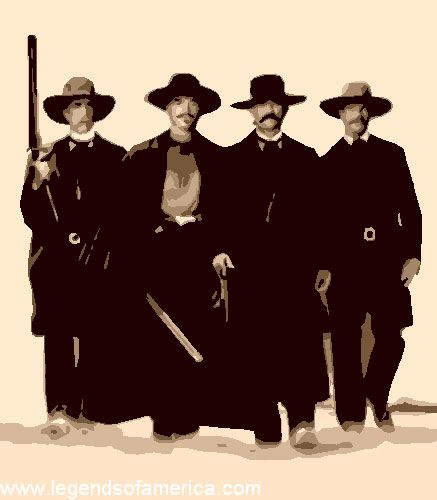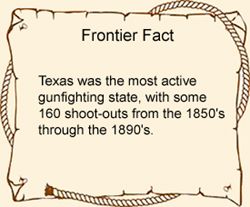“The most important lesson I learned was the winner of gunplay usually was the one who took his time. The second was that if I hoped to live on the frontier, I would shun flashy trick-shooting as I would poison. I did not know a really proficient gunfighter who had anything but contempt for the gun-fanner, or the man who literally shot from the hip.”
— Wyatt Earp
Though movies and television would like us to believe otherwise, it was infrequent when gunfights occurred with the two gunfighters squarely facing each other from a distance in a dusty street. This romanticized image of the Old West gunfight was born in the dime novels of the late 19th century and perpetuated in the film era to such a point that this fictional version is what our mind’s eye quickly conjures up when we hear the word “gunfight.” In actuality, the “real” gunfights of the Old West were rarely that “civilized.”
In fact, there are several misnomers about these “romanticized” gunfights, the first of which is that very rarely did the gunfighters actually “plan” a gunfight to occur by calling out their enemy for a duel in the street. Instead, most of these fights took place in the heat of the moment when tempers flared, and more often than not, with the aid of a little bottled courage. They also didn’t occur at a distance of 75 feet, with each gunfighter taking one shot, one falling dead to the ground, and the other standing as a “hero” before a dozen gathered onlookers.
Instead, these fights were usually close-up and personal, with several shots blasted from pistols, often resulting in innocent bystanders being hit by a bullet gone wild. Much of the time, it would be difficult to tell who had even “won” the gunfight for several minutes as the black powder smoke from the pistols cleared the air.
This is not to say it never happened, as in the movies. One of the rare instances is the Bill Hickok-David Tutt Shootout in Springfield, Missouri. Even then, it wasn’t a “planned” event; it happened when Wild Bill ran into Tutt in the street and was insulted.
They are always shown bravely facing each other in the popular westerns; in reality, the opponents were more often scampering for cover. The gunfights were not usually “clean” either, as the fighters were drinking and, missing typically easy shots, continued to shoot until they had emptied their pistol.
Of those gunfighters with a reputation as skilled shootists, they were not usually anxious to match their skills with another gunman with a similar reputation. Instead, they tended to avoid confrontation and undue risks whenever possible.
Gunfights:
Blackwell, Oklahoma Gunfight (1896)
Buckshot Roberts Last Stand (1878)
Cherokee Courtroom Shoot-out (1872)
Dalton Gang at Coffeyville, Kansas (1892)
El Paso Gunfight (1881)
Frisco Shootout (1884)
Harrison-Levy Shootout (1877)
Bill Hickok-Phil Coe (1871)
Bill Hickok-David Tutt Shootout (1865)
Hyde Park Gunfight/Newton Massacre (1871)
Lampasas Saloon Gunfight (1873)
Lampasas Square Shoot Out (1877)
Hunnewell, Kansas Gunfight (1884)
Ingalls, Oklahoma Gunfight With the Doolin Gang (1893)
Las Vegas, NM Saloon Shootout (1880)
Long Branch Saloon Shootout (1879)
Luke Short’s Last Gunfight (1890)
O.K. Corral Gunfight (1881)
Oriental Saloon Gunfight (1881)
Owens-Blevins Shootout (1887)
Rock Creek Station & the McCanles Massacre (1861)
Sandbar Fight (1887)
Luke Short-Jim Courtright Duel (1887)
Spokogee Gunfight (1902)
Talbot Cowboys Shootout (1881)
Trinidad, Colorado Saloon (1882)

Gunfighters.
As to the low-hanging holsters tied to the leg, that is a pure Hollywood invention. Most gunfighters carried their pistols stuck in their waistband, in a pocket, or a simple leather holster slipped on a belt.
 There are several gunfighters whose names were well-known while they were still alive and are just as quickly recognized today, including Wyatt Earp, Billy the Kid, Bat Masterson, Bill Hickok, and Doc Holliday. Their reputations spread by word of mouth, usually resulting in several exaggerations and inaccuracies. These already exaggerated tales grew more extensive with the retelling, often in the popular dime novels of the time. Other lesser-known shootists who saw just as much, if not more, action than their well-known counterparts were men such as Ben Thompson, Tom Horn, Kid Curry, King Fisher, Clay Allison, and Dallas Stoudenmire, to name a few.
There are several gunfighters whose names were well-known while they were still alive and are just as quickly recognized today, including Wyatt Earp, Billy the Kid, Bat Masterson, Bill Hickok, and Doc Holliday. Their reputations spread by word of mouth, usually resulting in several exaggerations and inaccuracies. These already exaggerated tales grew more extensive with the retelling, often in the popular dime novels of the time. Other lesser-known shootists who saw just as much, if not more, action than their well-known counterparts were men such as Ben Thompson, Tom Horn, Kid Curry, King Fisher, Clay Allison, and Dallas Stoudenmire, to name a few.
Here, you can read about many of the “real” gunfights of the Old West, where you’ll see the difference between television fiction and the real Wild West.
“If you want to hit a man in the chest, aim for his groin.”
— Bat Masterson
© Kathy Alexander/Legends of America, updated November 2025.
A fun video about Historic Hideout Pistols in the Old West from our friends at Arizona Ghostriders
Also See:
Adventures in the American West
Lawmen & Gunfighters Photo Gallery
See Sources.

